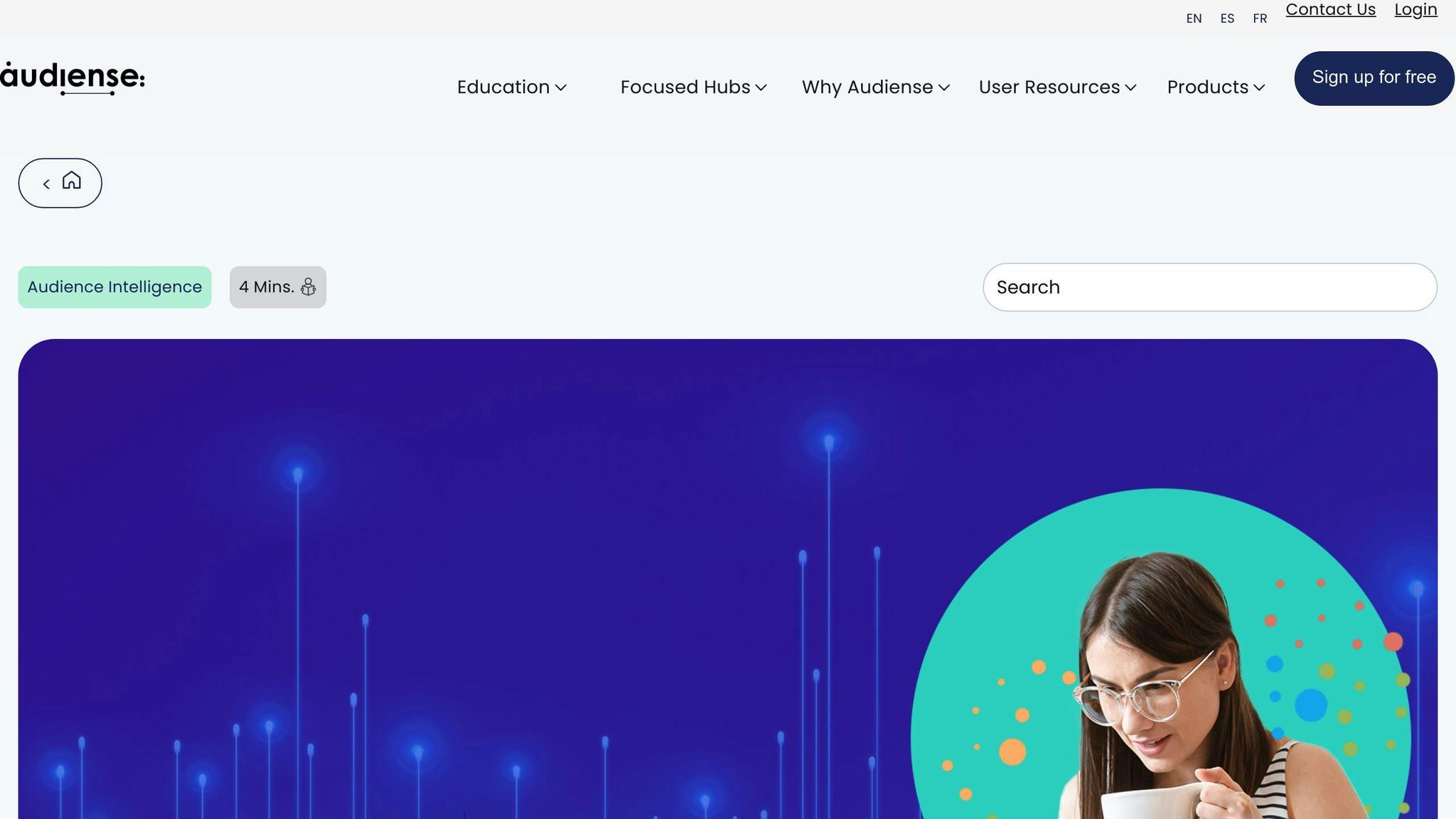Understanding your audience through data and analytics is crucial for expanding your market reach and finding new growth opportunities. Here's a quick overview of what this involves:
- Conduct Thorough Research: Analyze market trends and customer needs to identify new opportunities.
- Profile and Segment Your Audience: Understand who your customers are and categorize them for targeted marketing.
- Evaluate the Competitive Landscape: Look at what your competitors are doing and find your unique edge.
- Define a Strong Value Proposition: Clearly articulate why your product is the best choice.
- Implement Targeted Campaigns: Use data to craft precise marketing strategies for different audience segments.
- Refine Strategies Using Insights: Adjust your approach based on performance data to continuously improve.
By leveraging data and analytics, businesses can better understand their audience, tailor their offerings, and effectively reach new customers. This approach leads to more informed decision-making and strategic market expansion.
The Power of Data and Analytics
Using data and analytics is like having a superpower for understanding who might want to buy your stuff and spotting chances to reach even more people. By looking at different kinds of information, businesses can figure out a lot about what customers do, what they like, and what they need.
Types of Data
Here are three main kinds of information you can use:
- Customer data: This includes things like age, what they've bought before, how they use your website, and how they interact with you on social media. It helps you see who your customers are and what they're into.
- Financial data: This covers numbers on how much you're selling, how much money you're making, how much you're spending on ads, and how you set your prices. It shows you which marketing moves are actually making you money.
- Operational data: This is info on how much stuff you have in stock, how you get your products made, and how you send them out. It points out where you can make things run smoother.
Ways Data Informs Strategy
With all this info, you can:
- Find smaller groups of people who might really like your product
- Create messages that speak directly to what customers are interested in
- Make shopping feel more personal by knowing what each person likes
- Spot chances to sell more to people who already buy from you
- Figure out which ways of advertising work best, so you can spend your money there
- Keep customers coming back by always giving them what they want
Analytics Power Competitive Advantage
Businesses that really get into using data and numbers to make decisions can get ahead of the game. With good analytics, you can:
- See what customers need before your competitors do
- Keep making your selling process better
- Put more money into ads and efforts that bring in the most returns
- Use smart tech to make shopping easier and more fun
- Find new opportunities that others might not see
In today's world where everyone's trying to sell something, using data and analytics isn't just a nice-to-have - it's a must if you want to really understand your audience, grab new opportunities, and keep growing.
Methodologies for Audience Analysis

1. Research Into Your Target Audience
Getting to know your audience well is key to making smart marketing moves. Here's how to do it:
- Look at basic info like age, job, where they live, and how much money they make. This helps you understand what they might need or want.
- Watch how they act on your website or social media, like what they click on or buy. This shows you what they like about your brand.
- Ask them directly through surveys or chats to get their thoughts and feelings about your products or services. This gives you a clear picture of what they're looking for.
- Use tools like Google Analytics to see how people move around your website. This can tell you what grabs their attention.
- Check out other sources for more info, like market research reports or public data. This can add more depth to what you know about your audience.
By mixing these methods, you get a full view of your audience, helping you target them more effectively.
2. Segment Your Target Audience
Once you know your audience well, you can split them into specific groups for more focused marketing.
- Put customers into groups based on what they have in common, like their budget or lifestyle.
- Craft messages just for them, making sure what you say matches what each group cares about.
- Make shopping better for them by focusing on what each group values, from deals to eco-friendly products.
- Pick the right places to reach them, like specific social media platforms or email, depending on what each group prefers.
- Track how well you're doing with each group to see if they're responding to your efforts.
Breaking down your audience into smaller groups lets you connect with them more personally, which can lead to better results.
3. Create a Buyer Persona
With all your research, you can build detailed profiles for your target audience groups.
- Make them real by giving each persona a name, picture, and background story, including their likes and challenges.
- Focus on what they want to achieve and what's stopping them, especially how your product can help.
- Outline their buying journey, from first hearing about your product to loving it enough to recommend it.
- Highlight what drives them to buy, tapping into their emotions and values.
Having these personas helps you make decisions about your products and how to talk about them, making sure you're hitting the mark with your audience.
Identifying New Market Opportunities
1. Analyze Market Trends
It's important to keep an eye on what's happening in the market by looking at data. This can show us new chances to grow. For instance, if more people want eco-friendly products, it might be a good idea to start selling those. Or, if it's getting cheaper to use certain technologies, we could use them to sell to more places.
Always watch things like how many people visit your website, what they buy, what words they search for, and what they talk about online. This helps us see new trends early. Then, do more research to see if these trends fit with our plans.
2. Explore New Markets and Niches
We can use data tools to find new groups of customers or places we haven't sold to yet. First, decide what we're looking for in a new market, like how big it needs to be or how well our products fit there.
Then, look at the data to find parts of the market that match what we want. This could be new areas, different types of customers, or new ways people could use our products. Figure out if these new areas are worth going into by looking at things like how big the market is, how much it might cost to start selling there, and how much of the market we could get.
This way, we use numbers and smart planning to find the best new places to sell.
3. Understand Customer Needs and Pain Points
Looking at customer data helps us see what problems they have or what they wish they could get from us. Pay attention to what customers ask about, complain about, or why they might stop buying from us. Ask them how they feel about buying from us to find out what troubles them.
If a lot of customers have the same problem or want something we don't offer, that could be a chance to make something new. But first, we need to see how big this opportunity is by figuring out how many people have this problem and how much they'd like a solution.
By focusing on what customers really need, we can find new ways to help them and grow our business.
sbb-itb-5c5ac24
Developing a Data-Driven Market Expansion Strategy
Growing your business into new areas might seem tough, but if you use data wisely and understand what your competition is doing, you can find great new opportunities and connect with more customers. Here's a simple guide on how to do this:
Conduct Thorough Market Research
- Look closely at trends, what customers want, and where the industry is headed to find new places where you might do well.
- Spot areas where people really need something that's not being offered enough.
- Think about what you'll need to start selling in a new place, like understanding the rules or finding local partners.
Understand Your Target Customer
- Create detailed profiles of your ideal customers, including their age, interests, and what problems they have that you can solve.
- Talk to customers and ask them questions to get real insights.
- Listen to what people are saying about your products to figure out how you can improve.
Evaluate the Competitive Landscape
- See who else is selling similar things in the new market and what they're offering.
- Look for areas where these competitors are lacking, and think about how you can do better.
- Check out their prices, products, and how they talk to customers.
Define Your Value Proposition
- Explain why your product is different and better than others.
- Talk about what makes your business special.
- Show how you'll give more value to your customers.
Create Tailored Marketing Strategies
- Make sure your messages speak directly to what your target customers care about.
- Choose the right places to advertise, like social media or email, based on where your customers spend their time.
- Adjust your content to fit different places and cultures.
Continuously Optimize
- Keep an eye on how well your efforts are working and be ready to make changes.
- Try different prices, deals, and products to see what works best.
- Change your plan based on what customers are saying and how they're reacting.
By always looking at data, focusing on what customers want, and being ready to adjust, you can make your move into new areas a success.
Implementing and Measuring Success
When you're ready to grow your business by moving into new areas, it's important to plan carefully, do things step by step, and check if it's working. Here's how to do it right:
Create an Implementation Roadmap
First, you need a plan that lays out everything you need to do:
- Who will do what
- When things need to happen
- What you need and how much it will cost
- Key steps along the way
- What could go wrong and how to handle it
This plan helps everyone stay on the same page as you start expanding.
Collect Customer and Market Data
To do well in new places, you need to really understand what people there want, who else is selling similar things, and what's special about that market. Use tools like surveys, talking to people, and looking at research reports to gather this information.
Tailor Your Offerings and Messaging
Once you know more about each new place, adjust your products, how much they cost, special offers, and how you talk about them so they fit well with what people there are looking for.
Launch Targeted Campaigns
Create special campaigns for each new area, using different ways to reach people like social media, email, or ads. Make sure your campaign talks directly to what your new customers care about. Keep an eye on how these campaigns are doing and make changes as needed.
Closely Monitor KPIs
Decide what numbers (like how many new customers you're getting or how much money you're making) will tell you if you're successful. Use tools to watch these numbers closely in each new market. This helps you see how well you're doing and fix any problems quickly.
Refine Based on Insights
Always be looking at what your data is telling you about how customers are responding, what's happening in the market, and what your competitors are doing. Use this information to make your expansion strategy even better, making sure you're always meeting your new customers' needs.
By planning carefully, adjusting based on what you learn, and keeping an eye on your progress, you can grow your business into new areas successfully.
Conclusion
Understanding your audience through data and analytics is key for businesses that want to reach more people and find new chances to grow. By focusing on what the data tells us, companies can learn a lot about what their customers want and need. This information helps them make their products and messages just right for different groups of people.
Here are the main points for using data to help your business grow:
Conduct Thorough Research
Look closely at what's happening in the market and where things are headed to spot new areas you could do well in. Find spots where people aren't getting what they need.
Profile and Segment Your Audience
Make detailed profiles of your ideal customers to really understand what they're looking for. Identify different groups within your audience for more focused efforts.
Evaluate the Competitive Landscape
Check out what your competitors are doing and find ways you can offer something better. Look at what they're selling, how they talk about their products, and their prices.
Define a Strong Value Proposition
Make it clear how your product solves problems better than others. Tell people what makes your business special.
Implement Targeted Campaigns
Start specific campaigns for different groups, using the best channels to reach them. Keep making improvements based on what the data shows.
Refine Strategies Using Insights
Watch your results closely and listen to what your audience is telling you. Change your strategies based on what you learn to keep growing in new markets.
By really focusing on what your audience wants and using data to guide your decisions, you can find new opportunities and do well in new markets. Paying attention to the needs and preferences of your audience gives you a big advantage when you're trying to grow.
Related Questions
How does data analytics help understand an audience?
Data analytics lets us dig into who our audience really is by looking at stuff like where they come from, how old they are, what they like, and how they act online. It helps businesses figure out:
- Who's really interested in their stuff (like where they live, how old they are, etc.)
- What kinds of posts or products different people like
- How folks interact with their brand online
- Why people decide to buy something
- Ways to make shopping or browsing better for everyone
With this info, companies can make ads and products that really speak to their audience.
How do you analyze market data to identify opportunities and trends?
To spot new chances in the market:
- Look at reports and research to see what's growing and what people want
- Use tools to track how interests are changing over time
- Check out what your competitors are missing or not offering
- Ask your customers what they'd like to see more of
- Watch your sales to see if new types of customers are popping up
Keeping an eye on the latest market info helps you stay ahead and jump on new trends.
How do marketers use data analytics to reach customers?
Marketers use data to:
- Find and focus on the people who will most likely buy their stuff
- Make messages that match what certain people are into
- Figure out the best time to show ads or posts
- Decide where to spend their ad money for the best results
- See how well their ads are doing and make them better
By using data, marketers can make sure they're talking to the right people in the right way.
How can marketing analytics help businesses in identifying and understanding their target audience more effectively?
Marketing tools give businesses a lot of useful info, like:
- Who their best customers are and what they have in common
- What customers like and want
- Which ads work best and where
Using this info, businesses can make sure they're focusing on the right people and making ads that really connect with them. This leads to more people buying stuff and better results for the business.



